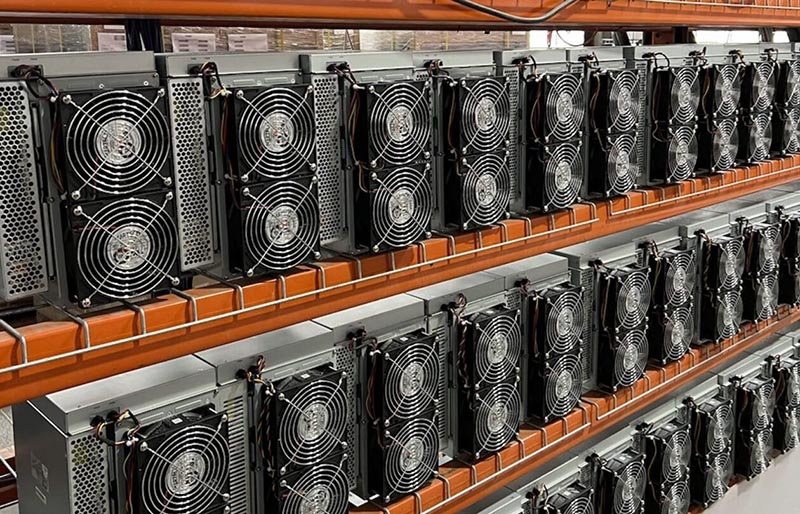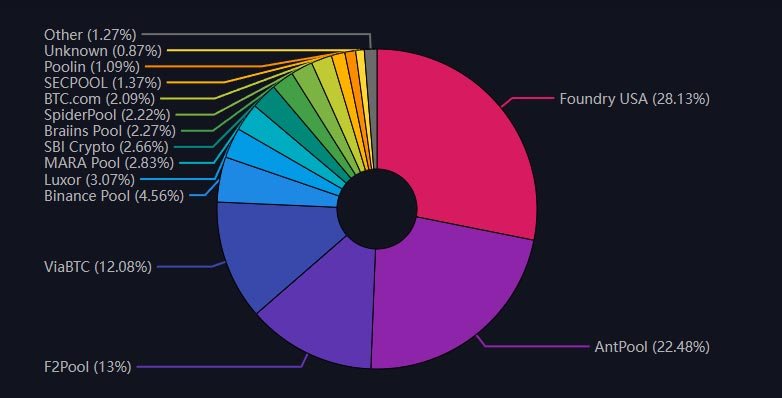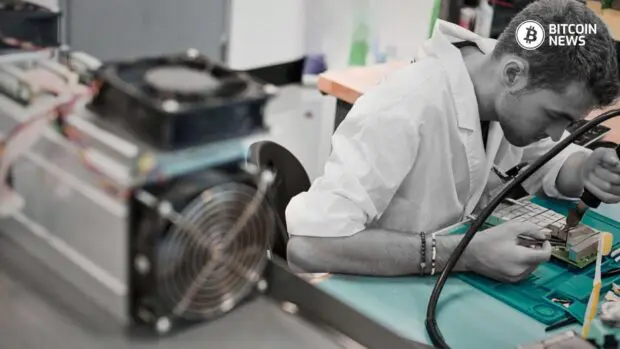The technology behind a Bitcoin mining rig is at the forefront of innovation, serving as the backbone of the decentralized network. As the technology evolves, from simple CPUs to advanced ASICs, these mining rigs continue to shape the landscape of Bitcoin mining, enhancing the network’s security and efficiency.
What is a Bitcoin Mining Rig?

A Bitcoin mining rig is a specialized computer system designed for processing Bitcoin transactions and securing the Bitcoin network. These rigs perform the complex calculations necessary to confirm transactions and include them in the Bitcoin blockchain—a process known as mining.
A typical mining rig includes powerful processors, chips called ASICs (Application-Specific Integrated Circuits), which are optimized to handle the repetitive hashing algorithms required for mining Bitcoin.
The objective of mining is to solve a cryptographic puzzle, which allows the miner to add a new block of transactions to the blockchain. Successfully solving this puzzle and adding a block rewards the miner with newly minted bitcoin, as well as transaction fees from the transactions included in the block.
The mining rig is essential in this process, providing the computational power necessary to compete with other miners and secure the network.
The Evolution of Mining Hardware
The evolution of Bitcoin mining rigs is a story of rapid technological advancement, driven by the escalating difficulty of mining Bitcoin as more miners join the network. Here’s a brief overview of how Bitcoin mining hardware has evolved:
CPU Mining (2009)
Initially, Bitcoin mining was performed using CPUs (Central Processing Units) on regular computers. This was feasible in the early days when the mining difficulty was low. The first Bitcoin miners used simple computers, and even laptops could mine multiple coins per day.
GPU Mining (2010)
As Bitcoin gained popularity, miners discovered that graphics processing units (GPUs) were far more effective at handling the computations required for mining. GPUs are better suited to performing the parallel operations needed for hashing algorithms, significantly increasing mining efficiency and speed.
FPGA Mining (2011)
Field-Programmable Gate Arrays (FPGAs) offered a further increase in mining efficiency. FPGAs are integrated circuits that can be configured by the customer or designer after manufacturing. These devices provided better performance than GPUs while consuming less power.
ASIC Mining (2013 to Present)
The introduction of Application-Specific Integrated Circuits (ASICs) marked a significant turning point in Bitcoin mining. ASICs are custom-built chips designed specifically for Bitcoin mining. They offer unparalleled processing power and efficiency compared to all previous technologies. ASIC miners dominate Bitcoin mining today, providing the immense hashing power required as network difficulty continues to rise.
Mining Pools and Cloud Mining
As individual mining became less viable due to increasing difficulty levels and the high cost of efficient mining rigs, miners started to pool their resources.
Mining pools allow individual miners to combine their computational power to increase their chances of solving blocks and earning rewards, which are then divided among the pool members.
Additionally, cloud mining emerged, allowing individuals to rent mining hardware and benefit from mining without managing the physical hardware.
Mining-Enabled Appliances Vs. Bitcoin Mining Rigs
Mining-enabled appliances represent a groundbreaking innovation in which Bitcoin mining technology is seamlessly integrated into everyday household devices.
Currently, devices like Bitcoin space heaters are being manufactured, paving the way for the future integration of mining capabilities into a wider range of appliances. Potential future applications could include smart refrigerators, televisions, and HVAC systems, transforming them into functional contributors to the Bitcoin network while fulfilling their primary functions.
These appliances could be fitted with ASIC chips or similar mining hardware, enabling them to mine Bitcoin while they operate or during idle periods, using small amounts of electricity.
This unique capability provides dual functionality—carrying out their primary tasks while simultaneously supporting the Bitcoin network through mining activities, potentially providing economic returns to the consumer.
“Bitcoin space heaters have the potential to transform the way we think about energy consumption and Bitcoin mining. Integrating Bitcoin with everyday household appliances blurs the lines between traditional infrastructure and emerging digital ecosystems.”
– BitcoinNews
As this technology matures, it has the potential to render traditional mining rigs obsolete in the distant future. By decentralizing mining activities across millions of household appliances, the need for dedicated, high-power mining setups could diminish.
This shift would not only reduce the hardware and maintenance costs associated with large-scale mining operations but also distribute the mining power more evenly across the network, enhancing its security and resilience.
For consumers, the attraction of mining-enabled appliances lies in the potential to offset some electricity costs through earnings generated from Bitcoin mining. Manufacturers might promote these benefits as a unique selling point, adding a new layer of value to their products in a highly competitive market.
From a broader perspective, integrating mining capabilities into widespread household items could significantly enhance the decentralization of the Bitcoin mining ecosystem.
This distribution of mining operations across numerous small-scale devices could prevent the concentration of mining power in large farms, thereby bolstering the security and robustness of the Bitcoin network.

In smart home environments, mining-enabled appliances could be integrated into holistic energy management systems. These systems would allow devices to communicate and dynamically adjust their mining activities based on real-time energy consumption, usage patterns, and peak electricity demand.
This integration could extend to smart grids, further contributing to overall energy efficiency and creating a more sustainable approach to Bitcoin mining in residential settings.
Technological Feasibility, Energy Efficiency And Sustainability
The concept of mining-enabled appliances involves significant challenges across technological feasibility, energy efficiency, and sustainability. Integrating mining hardware like ASIC chips into appliances requires complex engineering to ensure functionality without compromising their primary tasks. Durability is also a concern, as continuous mining increases wear and tear, necessitating robust design.
Sustainability challenges include increased resource consumption for manufacturing mining components and potential rises in e-waste due to accelerated appliance degradation.
Feasibility depends on local availability and costs. These barriers highlight the complex hurdles that must be overcome for mining-enabled appliances to be viable.
“The idea that Bitcoin mining is wasteful and bad for the environment is misleading at best. Bitcoin mining leads to more efficient power usage and more power generation, especially for the individual.
The systems that create incentives for wasteful use of power often via subsidies are what leads to environmental degradation.”
– Rev.Hodl — BitcoinNews
Conclusion
Bitcoin mining rigs have evolved significantly, beginning with CPUs and advancing to ASICs, which now dominate the field due to their superior efficiency. This progression underpins the decentralized nature of Bitcoin’s network.
Mining-enabled appliances represent an innovative leap, integrating mining technology into household devices like refrigerators and washing machines. This integration not only provides dual functionality but also has the potential to decentralize mining further and render traditional rigs obsolete.










